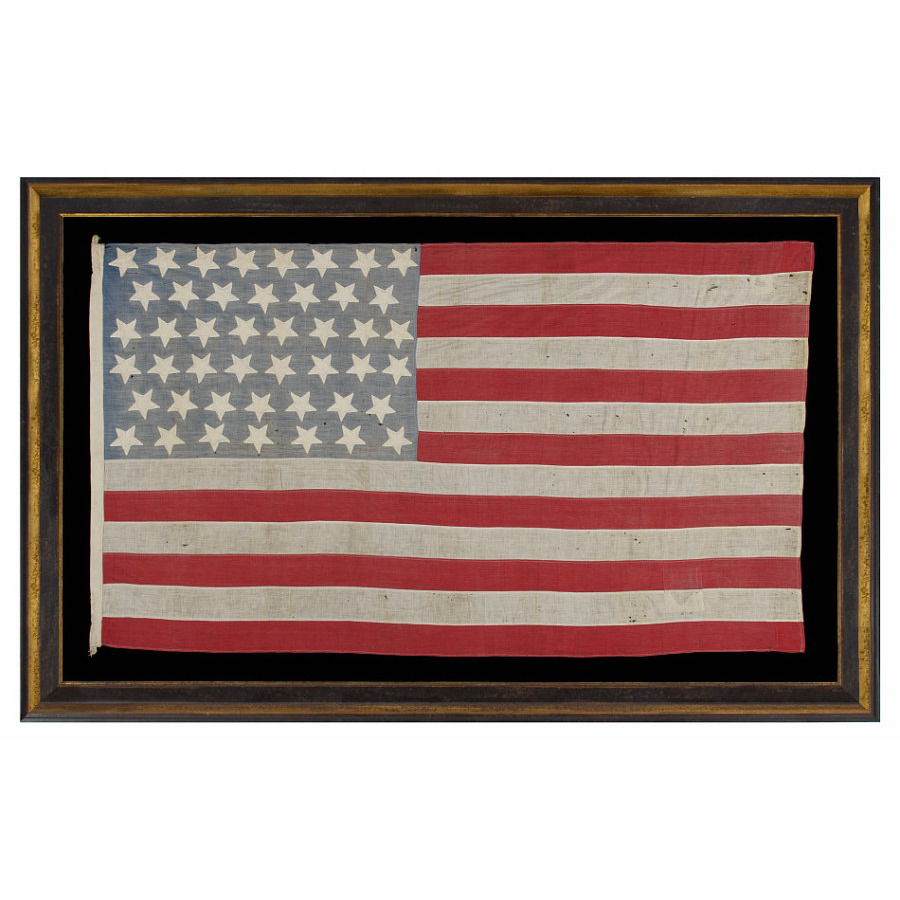
| |
45 UNUSUAL STARS ON A HOMEMADE COTTON FLAG WITH A BEAUTIFULLY FADED CANTON, 1896-1907, SPANISH-AMERICAN WAR ERA, UTAH STATEHOOD |
|
| Available: |
Sold |
| Frame Size (H x L): |
Approx. 49.5" x 78" |
| Flag Size (H x L): |
38.5" x 67.25" |
|
| Description....: |
|
45 UNUSUAL STARS ON A HOMEMADE COTTON FLAG WITH A BEAUTIFULLY FADED CANTON, 1896-1907, SPANISH-AMERICAN WAR ERA, UTAH STATEHOOD:
45 star American national flag, made in the period between 1896 and 1907, with a pleasing presentation and some especially unusual features. Chief among these are the stars, which appear with upside down positioning on a faded blue canton with the color of stone-washed denim. The stars were initially single-appliqued. This means that they were applied to one side only, then the blue field was cut away and under-hemmed, so that the one star could be viewed on both sides of the flag. This is an old method, most commonly seen in flags made prior to the Civil War (1861-65). In the 1860's it accounts for perhaps 20 percent of flags with appliqued stars. By 1876 the portion drops to perhaps 10 percent, and by 1890 probably accounts for less than 1 percent. More unusual, however is the fact that after the single-applique of the first set of stars was finished, either the maker--or someone else--decided to applique a second set of stars on the reverse. Perhaps this was done because the maker did not prefer the appearance of single-appliqued stars, which are smaller and typically less defined on the pierced side.
Applique work, when properly executed, is difficult enough that most modern day quilters are not capable of the task. Single-applique is harder still and evidence of a superior seamstress. Applying another set of stars required more work and while there was no real need to do it, adds a layer of academic interest to this antique textile.
Other flags are known with upside down stars. No one knows if this orientation had any purpose. It is entirely possible that the designer did not feel that any particular position was "right-side-up", but whatever the case may be, the circumstance is more interesting to collectors and the resulting graphics are more unusual to the eye.
Another unusual trait can be seen in the configuration of the stars. While there was no official star pattern for the American national flag until 1912, most surviving 45 star flags have alternating staggered rows in counts of 8-7-8-7-8-7 (or vice-versa). 46 star flags are most often encountered with an 8-7-8-8-7-8 arrangement of staggered rows. The latter makes the middle two rows even and keeps the design balanced. At first glance, this flag appears to contain 46 stars in the customary pattern, but on closer inspection one will find that the last row contains only 7 stars instead of 8, but in a wider spread to justify it with the longer rows above. To the best of my recollection, this is the only flag I have ever encountered with this particular configuration.
Utah became the 45th state in 1896. It had been attempting to gain statehood for many years, but remained a territory, primarily due to the fact that the Mormon Church and Utah authorities continued to be openly tolerant of polygamy. In 1890, Mormon Church President Wilford Woodruff published a manifesto that denounced the contract of "any marriages forbidden by the law of the land". This gave way to Utah's 1896 acceptance. The 45 star flag was generally used from that year until 1907, when Oklahoma joined the Union. Due to the Spanish-American War (1898) and Teddy Roosevelt's famous world tour of the "White Fleet" (launched in 1907), this was an extremely patriotic period.
Penciled lettering on the reverse side of the hoist binding appears to begin with the word "Clarabal," a somewhat common surname, then becomes more illegible. This would likely have been the name of a former owner of the flag, as it was common to mark flags in this fashion during the 19th century.
Construction: The canton and stripes of the flag are made of plain weave cotton that has been pieced with treadle stitching. Gussets (reinforcement patches) are present at the top and bottom of the fly end. The stars are made of cotton and single-appliqued to the obverse, then a second set of stars was appliqued on the reverse. The applique work was done by treadle machine. A sailcloth canvas sleeve binds the hoist. Through this a braided cotton rope was fitted, looped at either end, and stitched in place near the top and bottom.
Mounting: The flag has been hand-stitched to 100% silk organza for support on every seam and throughout the star field. The flag was then hand-stitched to a background of twill cotton, black in color, which was washed to reduce excess dye. An acid-free agent was added to the wash to further set the dye and the fabric was heat-treated for the same purpose. The mount was then placed in a black-painted, hand-gilded and distressed Italian molding. The glazing is U.V. protective plexiglass.
Condition: There is significant fading of the blue canton and modest fading of the red stripes, which is greater at the fly end. There is a patched hole between the 11th and 12th stripes, near the fly end. There is a scattering of tiny holes throughout and there is minor soiling. The penciled inscription is faded. |
|
|
|
| Collector Level: |
Intermediate-Level Collectors and Special Gifts |
|
| Flag Type: |
Sewn flag |
|
| Star Count: |
45 |
|
| Earliest Date of Origin: |
1896 |
|
| Latest Date of Origin: |
1907 |
|
| State/Affiliation: |
Utah |
|
| War Association: |
1898 Spanish American War |
|
| Price: |
SOLD |
|
| |
Views: 2643 |
|
|
|

